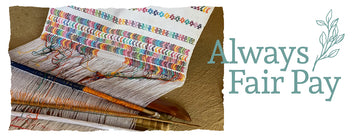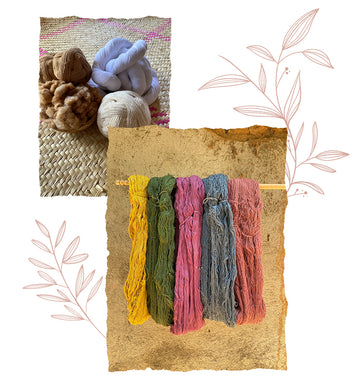Amaya and Fair Fashion
Fair fashion is undeniably one of the pillars of Amaya.
We understand this concept as part of another, Fair trade.

Fair trade is a concept that places human beings and the social, economic and environmental sustainability of societies at the center.
It also has to do with dignifying the artisans work, respecting the environment and promoting responsible and sustainable management of natural resources.
Fair trade provides organized small producers with direct access to the market under fair and equitable conditions, creating a sustainable, supportive and high quality marketing channel, as direct as possible between producers and consumers.
Another fundamental objective of fair trade is to promote a culture of responsible consumption because consuming means choosing what kind of development we want.

We ensure that Fair pay is given to all artisans that partner with Amaya. The price paid to artisans is not haggled over.
We respect the conditions that the artisans asks for in order to be able to produce the garments, considering that they represent the fair value for their work.
Absolutely No Child Labor
Children belong in schools and learning facilities. They are an integral part of the development of their communities.
We know their caretakers must earn enough money to keep them focused on books and developing their social skills by having a happy childhood.

Contribute to Cultural Preservation
Many of the techniques our artisans apply in the creation of our garments are ancient skills that have been passed down by generation to generation. In order to keep those techniques alive in this modern world they need to earn what they are worth.
Some of the garments that are produced for Amaya may take up to three months to conclude. For example the creation of the huipil, where the craftswomen use the backstrap loop as the main tool, a weaving instrument that dates back to pre-Hispanic times.
It is formed mainly by two groups of threads: the warp, which are the vertical threads that define the length and width of the fabric, and the weft, the threads that cross horizontally with the warp.
To assemble a loom, the ends of the warp must be tied to two wood or sticks called enjulios, which will support the weave and define the width. The upper end of the loom must be attached to a fixed point, it can be a tree or a post, while the lower end is held with a mecapal, a type of sash that the weaver holds with her waist to tighten the loom.
Using wooden sticks and their hands, the artisans weave the threads to create patterns in the textile. No guides or pre-planned designs are used, so the final result depends largely on the artisan's experience and skill. huipiles are modular garments; the width of the fabric corresponds to the width of the loom (which is usually between 30 and 40 centimeters), so it is often necessary to join several canvases to complete a garment. There is never any waste of fabric for this very reason, as the craftswomen make exactly the amount they need.

As for the motifs that decorate the huipiles, these depend largely on local beliefs, and in many cases their meaning is known exclusively within the community. In Mayan communities, for example, it is common to see rhombus designs, which refer to the three levels of the Mayan universe: the sky, the earth and the underworld.
These garments woven on the backstrap loom are true works of art that treasure the ideology and worldview of those who wove them, whose cultural heritage is a factor that unites them as a linguistic group and transmits cultural experience, language and identity to new generations.

Environmental Sustainability
For the European Union clothing should be part of a circular economy. This means that products, including clothing, should be more sustainable, longer-lasting and easier to repair and recycle.
Amaya aligns with this goal by offering pieces of clothing that counterpart the un-sustainable “fast fashion” industry. Timeless beautiful pieces that you can wear again and again with your current wardrobe and look spectacular every single time.
Not only that, Amaya works with artisans that predominantly use natural materials for their pieces that are biodegradable and avoid contaminating our waters with microplastics.



